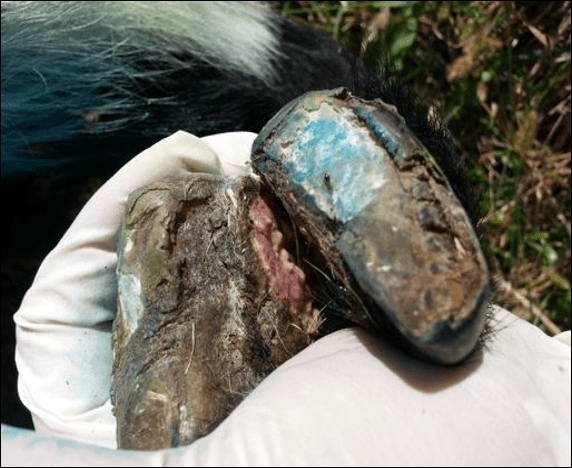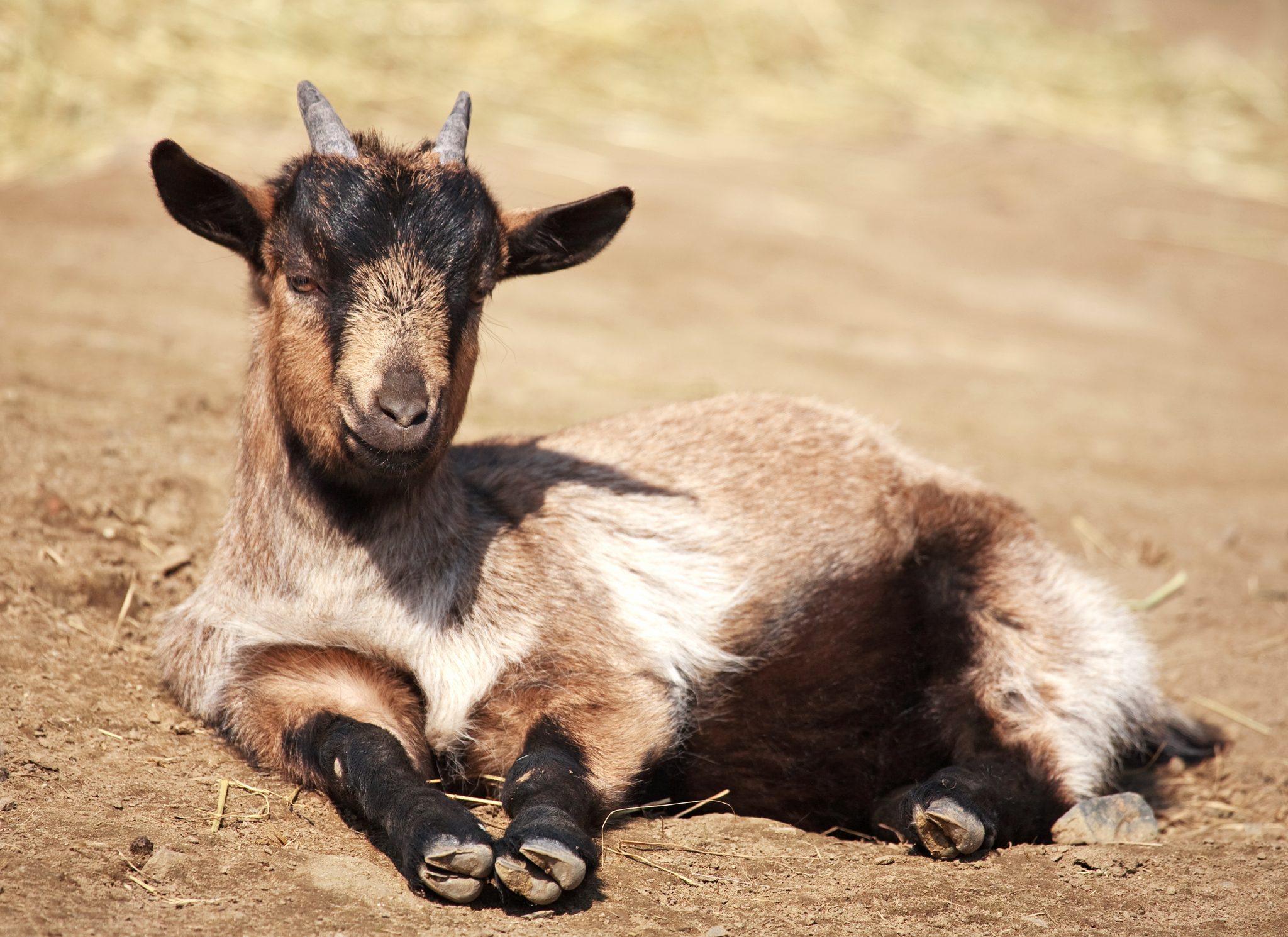Animals

Introduction

Foot Rot on Goat Hoof
Foot rot and foot scald are among the costliest diseases for sheep and goat producers. These diseases cause stress to the animals, affect reproductive weight rates, and decrease milk and wool production. Controlling and eliminating foot rot and foot scald in an infected herd or flock requires intensive labor and may be expensive for producers.
Foot rot is a contagious disease of the hooves in goats and sheep. This disease is prevalent in the Southern region of the United States due to the wet and humid climate. Foot rot is primarily caused by the microorganisms, Dichelobacter nodosus, which can be found in contaminated soil, and Fusobacterium necrophorum.
Foot scald, also known as benign foot rot or interdigital dermatitis, is inflammation between the toes caused by Fusobacterium necrophorum. Persistent moisture on the skin between the toes can increase susceptibility to foot scald. However, foot scald does not seem to be contagious. A significant proportion of the herd will likely show signs of this disease under ideal environmental conditions. Foot scald often leads to hoof rot.
How Foot Rot and Scald Spreads
How can foot rot and foot scald spread in a herd or flock?
- Introducing an infected animal into a non-contaminated herd can disseminate the disease (direct transmission of foot rot can occur between cattle, sheep, and goats sharing the same pastures).
- Foot scald and foot rot outbreaks occur most often during persistent rainy weather along with high temperatures when animals walk across wet pastures and muddy soil. If not treated, sick animals can become permanently infected.
- During the rainy season, infected animals can contaminate the soil, which can increase disease transmission to other animals.
- Overgrown hooves will also predispose an animal to foot scald or rot.
- Foot rot microorganisms can also be carried to the soil on visitors’ shoes.
Diagnosis
- The first signs of hoof rot or scald are limping, holding limbs above the ground, grazing on knees, and reluctance to walk.
- Foot scald is characterized by interdigital inflammation. The skin between the toes is pink to white in color, raw, moist, and very sensitive to the touch.
- Foot rot can be mild or severe. The erosion of tissue between the sole of the toe and the hard outer hoof characterizes foot rot. Upon trimming the hoof, the outer shell of the hoof will be separated from the inner sole. Severe cases of foot rot may be accompanied by the presence of pus and a foul smell. Animals severely affected can experience difficulties standing and may walk on their knees instead. They can also experience decreased feed intake and an overall decline in animal productivity.
Although foot rot and foot scald are common in small ruminants, they should also be inspected for other foot diseases or injuries.
Treatment
- Isolate affected animals for treatment and trim hooves. Check for signs of rot or scald and rule out other possible causes of lameness.
- Treat the feet with a solution of 10 percent copper sulfate or zinc sulfate or use 7 percent iodine on the feet.
- When a substantial number of herd animals are affected, using a footbath may be the best treatment option. Animals must stand in a zinc or copper sulfate solution every 5-7 days for 15 minutes to allow absorption into the hoof wall.
- Another option for whole herd treatment is the use of absorptive pads saturated with zinc or copper sulfate solution. The pad should be placed in a high-traffic area that goats and sheep must pass through, such as a gate, lane, or water trough.
- Keep treated animals in a dry environment for 24 hours after treatment. Hooves should be trimmed as needed to expose the infected tissue to oxygen.
- Maintain clean pens and barns. Foot rot microorganisms can remain in the soil for several weeks. Animals should be transported to a clean pasture after treatment.
Prevention
- Cull highly susceptible animals and enhance selective breeding for resistance to foot rot.
- Trim hooves regularly. Trimming prevents hoof overgrowth, which creates an environment for foot rot.
- Check animals for foot lesions before purchasing.
- Give animals a footbath upon returning from shows or after purchasing, and prior to their re-entry into the herd.
Summary
If not well managed, foot rot and foot scald can cause significant economic losses for sheep and goat producers. Eradication of the diseases requires much labor and effort through hoof trimming, soaking, and regular checking of animals for any signs of hoof infection. Purchasing animals from a trusted source and consulting a veterinarian before using any drugs can help to prevent or eradicate foot rot and foot scald on a farm.
References
- Clifton, Rachel, Katharina Giebel, Nicola L. B. H. Liu, Kevin J. Purdy, and Laura E. Green. 2019. “Sites of Persistence of Fusobacterium necrophorum and Dichelobacter nodosus: A Paradigm Shift in Understanding the Epidemiology of Footrot in Sheep.” Scientific Reports, 9, no. 1, 1-11.
- Ehrhardt, Richard. 2020. “Tactics to Win the Battle Against Foot Rot.” Michigan State University Extension.
- Fesseha, Haben. 2021. “Ovine Footrot and Its Clinical Management.” Veterinary Medicine: Research and Reports, 12, no. 95, 215-224.
- Tizard, Ian R. 2021. “Sheep and Goat Vaccines.” Vaccines for Veterinarians, 215.
- Zanolari, Patrick, Salome Dürr, S., Jorg Jores, J., Adrian Steiner, and Peter Kuhnert. 2021. “Ovine Footrot: A Review of Current Knowledge.” The Veterinary Journal, 105647.
 Revised by Valens Niyigena, Ph.D., Extension Animal Scientist; and Bobwealth Omontese, DVM, Ph.D., Assistant Professor, Alabama A&M University. Originally written by Maria Leite-Browning, DVM, retired Extension Animal Scientist, Alabama A&M University.
Revised by Valens Niyigena, Ph.D., Extension Animal Scientist; and Bobwealth Omontese, DVM, Ph.D., Assistant Professor, Alabama A&M University. Originally written by Maria Leite-Browning, DVM, retired Extension Animal Scientist, Alabama A&M University.
Revised August 2022, Managing Foot Rot and Scald in Goats and Sheep, UNP-0087

